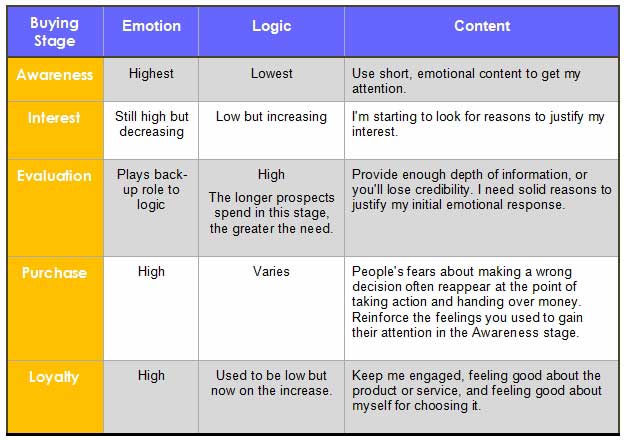The saying "people buy on emotion and rationalize with logic" has been around so long that people rarely question it.
But in content marketing, you need to question it. Otherwise, you run the risk of either not providing people the right information or—worse—alienating your audience.
The idea that people buy solely on emotion is old-school selling. Nowadays, buyers are running the show more than ever. Selling solely on emotion can make you come across as condescending and slimy.
It's obvious that emotions are big motivators for people making purchases. After all, we're human and emotions are a large part of how we operate. However, they're not the only part. We're not just emotional; we also have the capacity to think and question.
Under old-school selling, people felt manipulated—which is why they started turning to the Internet and to friends for answers rather than engaging with salespeople.
So, what's a better way? When you start to realize that people use both emotion and logic in making buying decisions, you can start creating much more powerful content marketing materials that really serve your buyers.
Better yet, when you understand how emotion and logic function within your buying cycle, you have the framework for creating not just good content but also great content marketing strategy.
That framework helps you to know what kind of content to produce, how to capture and keep people's attention, and even what formats to use for your marketing and when. You can create great content that provides people with what they need at each stage of your buying cycle.
Content Marketing: The Growth of a Trend
Traditionally, content marketing operated differently from interrupt marketing. The idea was that you created content and either sent it out or placed it where potential buyers would be likely to find it.
With the Internet, content marketing took off. You could produce content and place it on the Web for people to find at their convenience.
That has meant your company can be selling around the clock. Some night owl can be checking out your company while you're tucked up all comfy in bed. Or someone half a world away can be learning about your company while you're at lunch.
Content Marketing: Today's Little Black Dress for Companies
Today, content marketing is a necessity for most companies. Most people turn to the Internet to research a company or product. They expect to find information—or they turn elsewhere.
As a result, the popularity of content marketing has exploded.
Like all trends, it presents new challenges and opportunities. Today's challenge for most companies? Getting the right people to find your content found in the crazy sea of information online.
Using the right balance of logic and emotion at the right stage of your buying cycle increases the likelihood of people finding and consuming your content.
Let me give you an example of how this helped me in my own business. I produced an e-book called Using Ebooks in Content Marketing (PDF). I interviewed companies from across North America and put their strategies into the book. The only problem? It's a book: It's fairly long. Unless people needed that information immediately, they often felt they didn't have time to look at it.
I realized I needed something shorter to engage people. I produced a quirky 99-second video about my writing services called "Content About You." I got a lot of positive feedback on it, but the really surprising thing was the number of people who also told me how great my website was.
That was weird because I'd sent out a launch of my site to many of these people and had heard nothing. I realized that once I engaged them with the shorter content, they wanted to connect with me and my materials more. After enjoying my video, they went to my website and spent much more time there then they would have otherwise.
Using Emotion and Logic in the Buying Cycle
So, let's dive in and examine how emotion and logic operate in each stage of the buying cycle.
The following table is a summary of the buying stages and the types of content appropriate for each stage; in Part 2 of this article, I'll present a much more comprehensive table.

Stage 1: Awareness
In the first stage of the buying cycle, Awareness, people aren't aware of you or the need for what you offer. Emotional content is indispensable at this stage. Triggering emotion gets you noticed because in the human psyche emotion is the signal that says, Pay attention, this is important! Our brains are wired to pay attention to emotion and new or unusual things.
Besides getting attention, emotions are how we connect. We don't care about something—whether a person or problem—unless we make that emotional connection.
Triggering emotion also increases memory. People don't buy in the Awareness stage. The challenge of marketing is to get people to remember your company when they finally get to the point when they are ready to buy. Emotion is key to that. Content that triggers emotion is remembered better than the same content that doesn't.
Therefore, in the awareness stage, you want high emotional content and not much focus on logical content.
For one thing, at this early stage, your content has to be short. People don't know your company or why they need what you offer, so they're not willing to invest a lot of time. Also, providing a lot of logical content at this point isn't useful because you haven't established the emotional connection that makes people want to hear what you have to say.
Marketing can use a variety of emotions to get people's attention. Think what works for your audience and buying cycle.
Traditionally, marketers keyed into the emotion that the problem evoked—like the fears and anxieties that keep people up at night. And those still work—particularly when your marketing is focused on an individual. The drawback is that attracting people with negative emotions can sometimes leave them feeling manipulated or exploited.
A lot of companies have turned to using novelty or humor to get attention instead. Plus, funny, weird, and inspirational are what tends to get shared on social media.
One of the formats most effective for the Awareness stage is short-form video. Video is such a flexible format that it makes it easy to find creative ways to create emotion and engage people's brains.
Red Bull built a series of black and white animated videos around its tagline: "Red Bull gives you wings." They are an example of marketing using humor and unexpected twists to gain attention.
A video that stopped me online (and that's uncommon) was the Speedface campaign by Rogers Canada. The faces were just so strange-looking that I kept watching to the end rather than clicking by to get to my YouTube video. Part of me was laughing, while another part was a bit concerned the people might be permanently disfigured. And I was actually curious to see what on Earth was being advertised.
A television commercial, Evian's roller babies video, went viral. Within weeks of its release, it had 6 million views on YouTube. Three years later, it's still making the rounds with over 70 million views (and more on other versions):
The content is emotional—entertaining and focused around the incongruity of babies on skates. Yet Evian ensured that it got its central message across: Evian water supports your body's youth.
In Part 2, we'll go through the Interest, Evaluation, Purchase, and Loyalty stages.




